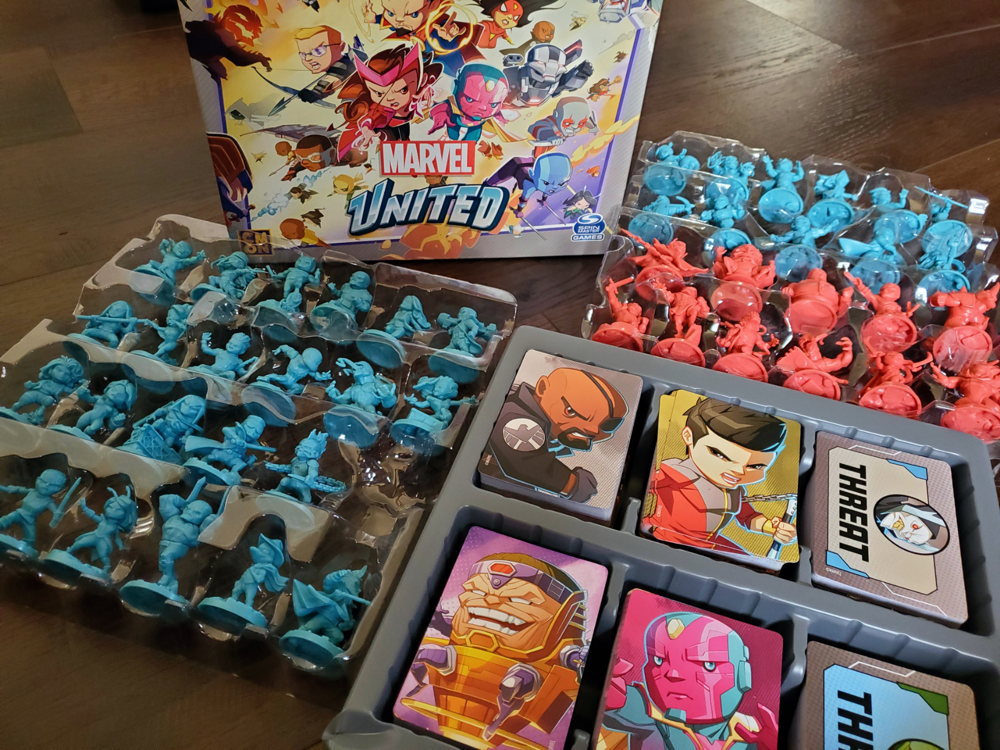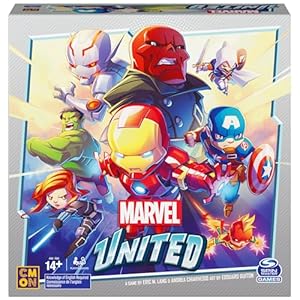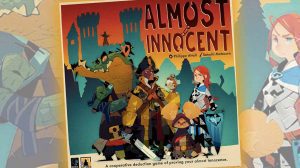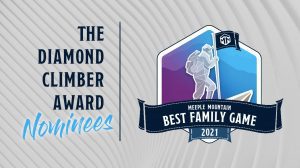Marvel United was the pledge that started it all. For me personally, Marvel United was the very first game I backed on Kickstarter. I had no idea what I was getting myself into when I opened my wallet to a CMON production. I kept hearing about these stretch goal things, not fully realizing they were all going to show up at my door in an oversized box months later. That pledge opened a floodgate of Kickstarter spending that has only recently subsided as I’ve better learned to curate my collection.
Looking beyond myself, though, the first appearance of Marvel United started a different sort of flood. The base game, designed by Eric M. Lang and Andrea Chiarvesio, gave players the opportunity to engage more than 50 Marvel superheroes in cooperative battle against more than two dozen Villains. The two subsequent campaigns have each added as many characters to the fold, resulting in an empire of cash and plastic that has now reached into second, third, and maybe fourth tier Marvel personalities? At this point, publisher CMON simply whispers the name and millions of dollars materialize to produce miniatures of unheard-of characters with little more than a cameo in a two-issue comic arc from the 1980s.
It’s amazing, really.
I only jumped in on that first pledge, and only for about 60% of the content. Three years later, I’ve not yet played as every character I own, but I’m still playing Marvel United, and that says something about the game underneath the intellectual property.
In the round
Marvel United is simple in its design. Six location cards laid out around a central hub containing a Villain’s modus operandi and some trackers to mark heroic accomplishments. Each player’s Hero and the Villain move around the locations—the Villains wreaking havoc and the Heroes cleaning up the mess to get a shot at socking the bad guy. At the start, the Heroes take three actions for every one from the baddy, with every action determined by cards. The game continues until either the Villain meets their objective or the good side wins.

Villain cards typically have three effects. First is clockwise movement to determine the target location of their fury. Second is a potential BAM action, the character-specific attack that pours forth from the fury. Third is the directed arrival of thugs and civilians begging to be either punched or set free. Each location holds a set number of these ordinary folk that must be handled in the course of the game in order to progress the story.
Adding annoying strength to the Villain, each location also contains a Threat card that creates a specific game condition. As the Heroes travel about, they spend actions to resolve these Threats, with each then unlocking a useful bonus ability and moving the game towards its undoubtedly CGI-heavy third act fight scene.
The story progression is also marked by cards and tokens that track how many thugs have been punched, civilians rescued, and Threats resolved. When one card is full, the Villain, in fear and wrath, takes actions more often. After two, the Villain (finally) becomes susceptible to damage. If three are complete, the Heroes draw a bonus card and press on to victory.

The Heroes are simpler yet. Every card bears either one or two of the basic actions: Move, Punch (Attack, really, but the icon is a fist and so we only ever say Punch), or Rescue. There is also a Wild icon that is obviously quite useful. Some cards also bear character-specific powers that pump up the volume on the attack. When a card is played, the player utilizes the symbols on their own card plus those of the previously played Hero card. These cards, along with the intermittent Villain cards, are laid out in a circular storyline that wraps around the central locations.
Apart from the specifics related to each character, this is Marvel United in a nutshell.
In character
There was a moment when my eyes were opened to the delightful blend of characters and mechanics in Marvel United. We were playing against the Villain Rhino, a regular in the world of Spider-Man known for, wouldn’t you know, dipping his head and charging. As he forcefully makes his way around the locations of the game, fittingly, he strikes characters, knocking them into adjacent locations with his vicious BAM. The more spaces he moves, the greater the damage. See, that makes sense.
There are loads of these little character quirks in the Villains. Red Skull succeeds by breeding fear. Kang comes and goes from the board, potentially returning each time at full strength. Dormammu can’t be defeated, he can only be outlasted. Killmonger replaces thugs and civilians with chaos. Thanos snaps Heroes out of the game (yes, there is a gauntlet with stones). There are only these tiny differences from one baddy to the next, but they are enough to give each outing a distinctive flavor.
Likewise for the Heroes. Characters like Black Widow, Squirrel Girl, and Doctor Strange have their ways of discovering and changing what the Villain will do next. Folks like Ant-man and Hulk have their moments of absurd strength. Shuri and Nick Fury make everyone around them stronger. Howard the Duck’s Neutron Disintegrator is as overpowered as it should be. Yondu’s Yaka Arrow Whirlwind is fast and furious. Drax punches everything and rescues nothing. The fun in the game is in assembling some ragtag collection of supers and seeing what happens when their often ill-fit powers join forces.

In addition to the base game, I have the Rise of the Black Panther and Infinity Gauntlet expansions. Each comes with unique locations, characters, and tokens as needed to create a fantastic experience. The Infinity Gauntlet, in particular, adds only Villains and a campaign in which Thanos’s sidekicks are collecting Infinity stones to equip him for what will be an epic last battle.
To gain an idea of the scope of products available: even in that first Kickstarter, I passed on the Guardians of the Galaxy box, the Return of the Sinister Six box, Enter the Spider-Verse, and the Tales of Asgard. There are more than fifty years of comic book stories available if the world doesn’t run out of plastic first.
In consideration
I suppose I should be honest with you at this point. First, I am not a Marvel nut. Don’t get me wrong, I grew up on comics and I have a nostalgic love of the campy Golden and Silver age trades. These days I enjoy graphic novels, but more outside the superhero genre than in. So there’s that. Second, I don’t often go for cooperative games. They just aren’t my thing. My favorite co-op, a small indie Kickstarter called Immune, has as much to do with my wife’s and my thematic preferences and the game’s backstory than anything else. Other than a few little kid games, like Kraken Attack!, you’ll not find me at the table often for a co-op.
That said, I get along with Marvel United. The initial investment was for my sons and their comic tendencies. It was a hit with one, and eventually became a hit for our third son. If I walk into the room, as I did just the other day, and say, “Marvel United?” they’ll look at each other, raise an eyebrow and say, “Yeah.” A game takes about a half hour. We all love digging through the minis to decide which is calling to us for the experience. Every game feels like a short story as we float about dismantling evil schemes.

Mechanically, this one is so very approachable. There’s a reason it’s on the shelves at Walmart. This is the sort of game that can convince the wider world that there’s a bit of variety in the tabletop gaming hobby—without intimidation. It helps that the intellectual property is among the hottest on the planet. The artwork is friendly, even for the most dastardly characters. The rulebook is short, sweet, and effective. The iconography is crystal clear from top to bottom. The very limited card text makes perfect sense. It’s so clean and simple you might assume there’s not much to it.
And in one sense, there isn’t. Our win rate is over 90% (true to comic book form). Regardless of the Villain, regardless of the combination of Heroes, victory is always possible. But at the same time, most of our games end within a turn or two of defeat. This tells me we most often make good decisions. One or two slips and we might be playing again immediately to avenge a tight loss. As it is, we choose to play again just to see what we can do with a different setup. This is probably for the best for a guy who doesn’t salivate over cooperative games.
I can’t imagine what it looks like for folks who own everything in the Marvel United line. We bring all four boxes out so that we have the full complement of personalities at our fingertips. What must that be like with 20+ boxes? Maybe that’s a struggle for the completionist—the inconvenience of bringing out a whole box just to extract one obscure Spidey-variation or X-person.
From a component standpoint, everything is adequate. The money is in the minis. But if you’re a miniature painter and any sort of Marvel fan, these games are the stuff of your dreams. If you’re not a painter, there’s nothing wrong with the blue, red, and purple pieces. There are even a few translucent orange accessories tacked on to characters here and there in the subsequent Kickstarter projects.

I don’t have much more to say. Marvel United is fun. I think it’s a little more fun with a little more variety. I would hardly say all the rigamarole of three Kickstarters is necessary. Far from it. But I could see the base game getting stale after enough plays to try all the Heroes and defeat all the Villains. So if you’re looking to invest, I’d suggest the base game and maybe one other title in the series, just to have variety and a different storyline. I highly recommend Infinity Gauntlet for its story content. It is replayable—the whole saga in a couple hours—and a little different every time. Of course, if you have access and cash, the Kickstarter Promo Box from the first campaign is the jackpot—33 Heroes (ones you’ve actually heard of, unlike the more recent campaigns) and 11 Villains to match.
All told, I’m glad this one’s out there. I’m curious to see how far the empire can extend, even if my own collection has probably reached its limit.












But how does this compare to Invincible? That’s what I need to figure out.